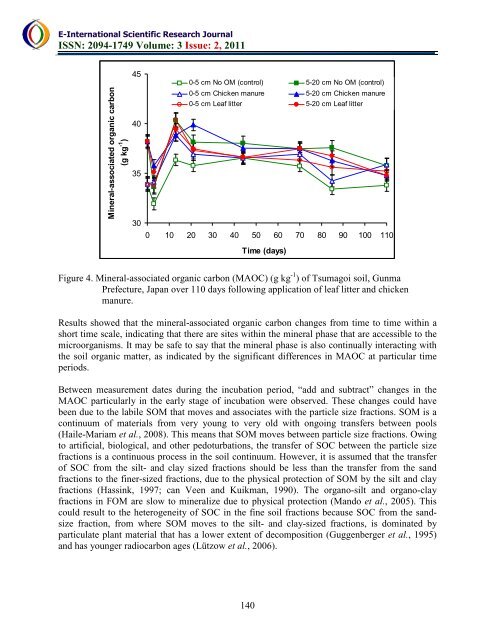download the full article here - E-International Scientific Research ...
download the full article here - E-International Scientific Research ...
download the full article here - E-International Scientific Research ...
You also want an ePaper? Increase the reach of your titles
YUMPU automatically turns print PDFs into web optimized ePapers that Google loves.
E-<strong>International</strong> <strong>Scientific</strong> <strong>Research</strong> Journal<br />
ISSN: 2094-1749 Volume: 3 Issue: 2, 2011<br />
45<br />
0-5 cm No OM (control) 5-20 cm No OM (control)<br />
Mineral-associated organic carbon<br />
(g kg -1 )<br />
40<br />
35<br />
30<br />
0-5 cm Chicken manure 5-20 cm Chicken manure<br />
0-5 cm Leaf litter 5-20 cm Leaf litter<br />
0 10 20 30 40 50 60 70 80 90 100 110<br />
Time (days)<br />
Figure 4. Mineral-associated organic carbon (MAOC) (g kg -1 ) of Tsumagoi soil, Gunma<br />
Prefecture, Japan over 110 days following application of leaf litter and chicken<br />
manure.<br />
Results showed that <strong>the</strong> mineral-associated organic carbon changes from time to time within a<br />
short time scale, indicating that <strong>the</strong>re are sites within <strong>the</strong> mineral phase that are accessible to <strong>the</strong><br />
microorganisms. It may be safe to say that <strong>the</strong> mineral phase is also continually interacting with<br />
<strong>the</strong> soil organic matter, as indicated by <strong>the</strong> significant differences in MAOC at particular time<br />
periods.<br />
Between measurement dates during <strong>the</strong> incubation period, “add and subtract” changes in <strong>the</strong><br />
MAOC particularly in <strong>the</strong> early stage of incubation were observed. These changes could have<br />
been due to <strong>the</strong> labile SOM that moves and associates with <strong>the</strong> p<strong>article</strong> size fractions. SOM is a<br />
continuum of materials from very young to very old with ongoing transfers between pools<br />
(Haile-Mariam et al., 2008). This means that SOM moves between p<strong>article</strong> size fractions. Owing<br />
to artificial, biological, and o<strong>the</strong>r pedoturbations, <strong>the</strong> transfer of SOC between <strong>the</strong> p<strong>article</strong> size<br />
fractions is a continuous process in <strong>the</strong> soil continuum. However, it is assumed that <strong>the</strong> transfer<br />
of SOC from <strong>the</strong> silt- and clay sized fractions should be less than <strong>the</strong> transfer from <strong>the</strong> sand<br />
fractions to <strong>the</strong> finer-sized fractions, due to <strong>the</strong> physical protection of SOM by <strong>the</strong> silt and clay<br />
fractions (Hassink, 1997; can Veen and Kuikman, 1990). The organo-silt and organo-clay<br />
fractions in FOM are slow to mineralize due to physical protection (Mando et al., 2005). This<br />
could result to <strong>the</strong> heterogeneity of SOC in <strong>the</strong> fine soil fractions because SOC from <strong>the</strong> sandsize<br />
fraction, from w<strong>here</strong> SOM moves to <strong>the</strong> silt- and clay-sized fractions, is dominated by<br />
particulate plant material that has a lower extent of decomposition (Guggenberger et al., 1995)<br />
and has younger radiocarbon ages (Lützow et al., 2006).<br />
140

















